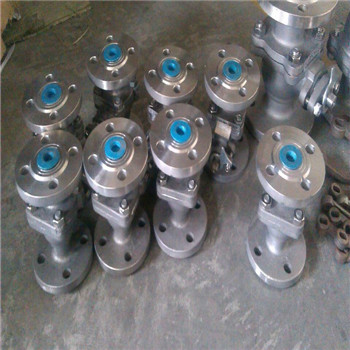How to improve the wear resistance of titanium alloy valve
Select the oxidation treatment conditions should be considered wear resistance, taking into account the valve wear life and fatigue characteristics should be determined when the appropriate oxidation conditions. Not suitable for mass production. The most suitable method is oxidation treatment. Titanium alloy valve development is the biggest issue of wear-resistant surface treatment technology development. Surface treatments such as TiN coating, Mo injection layer, and Cr sputtering are expensive, and it is sometimes difficult to maintain the wear resistance for a long time. That is, a high concentration of oxygen is dissolved in titanium to improve its hardness, and a thicker hardened layer is obtained internally. Oxidation is basically a simple heat treatment in the high temperature region of the atmosphere to heat and heat. However, low creep resistance of Ti-6Al-4V titanium valve is the usual annealing organization, due to its weight during processing easily deformed. Needle-like tissue with excellent creep resistance is the basic structure of the valve, but the ductility and fatigue properties of this structure are minimal. Therefore, by controlling various cooling conditions after heating in the β region, precipitation of a coarse α phase at the grain boundary can be prevented to obtain a very fine needle-like structure, ensuring high ductility and fatigue at the same time as the equiaxed structure Controlling the creep deformation during oxidation.
Using the specimen cut out from the stem portion of the actual manufacturing process, the tensile properties were evaluated. The tensile properties amounted to 980 MPa and the elongation rates were as high as 12% or more. It was further confirmed that even the needle-like structure obtained high fatigue characteristics not inferior to the equiaxed material. Ti-6Al-2Sn-4Zr-2Mo-0.1Si6242S is the typical alloy used in the exhaust valve exposed to elevated temperatures in use. However, the two-wheeled vehicle is more susceptible to long-term exposure to the high temperature region than the four-wheel valve, Thermal better TImetaL1100Ti-2.7Sn-4Zr-0.4Mo-0.45Si This alloy is one of the best heat-resistant alloys in practical titanium alloys, but its durable temperature is about 600 ℃, while the two-wheel exhaust valve Required to have about 800 ℃ heat resistance, it is necessary to choose the best heat treatment conditions, and then explore whether the applicable. Therefore, under different heat treatment conditions, the tensile properties at room temperature to 800 C, high temperature creep characteristics, impact properties and fatigue properties were evaluated in order to match the best material properties and make engine valves under suitable conditions.
However, if the conditions are poorly controlled, the layer is hardened to improve the wear resistance of the valve. Is ensure that fatigue performance is extremely reduced. Therefore, to grasp the best heat treatment conditions is particularly important. So in the temperature range of 670 ~ 820 for 1 ~ 16h atmospheric heat treatment, surface properties and surface hardness distribution was measured at the same time to investigate the impact of oxidation conditions on fatigue properties. The best heat treatment room temperature ~ 700 ℃ temperature range,. 0.2% yield strength higher than ordinary steel exhaust valve SUH35800 ℃ near the two are basically the same. The fatigue properties of this alloy at 800 C are also the same as for SUH35. The most worrying resistance to elevated temperature creep is also superior to the SUH35, meaning that proper heat treatment of the alloy ensures the valve's various characteristics.
Surface hardness distribution of specimens subjected to oxidation treatment at different temperatures for 1 hour. The surface hardness distribution of the samples after oxidation at 670 and 820 for a different time. With the increase of the treatment temperature, the diffusion distance of oxygen in the titanium alloy increases, and deeper hardness can be obtained. In the temperature range of the test conditions, the maximum temperature for a long time is 820 ° C, the sample for 4h oxidation is about 50μm, the minimum temperature is 670 ° C for a short time, and the sample hardened for 1 hour has a thickness of about 10μm. (Ti02 oxygen diffuses into the matrix from here, the hardness of the outermost layer just under the etching is the same regardless of the heat treatment. However, micro Vickers hardness may be different from the surface layer to the depth of several μm Of the heat treatment conditions to confirm the greater hardness difference.At the same time, part of the high temperature and long time oxidation conditions, the oxidation of the hardened layer cracks, indicating that the oxidation treatment is not suitable.









